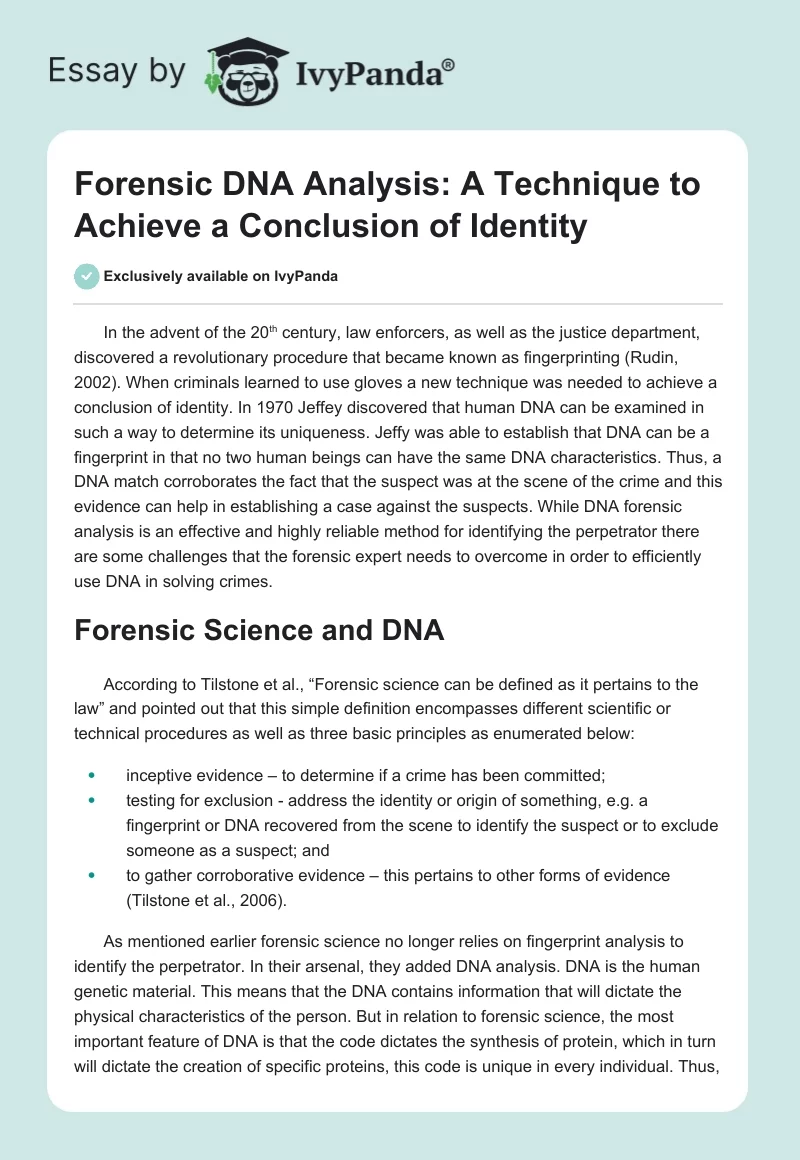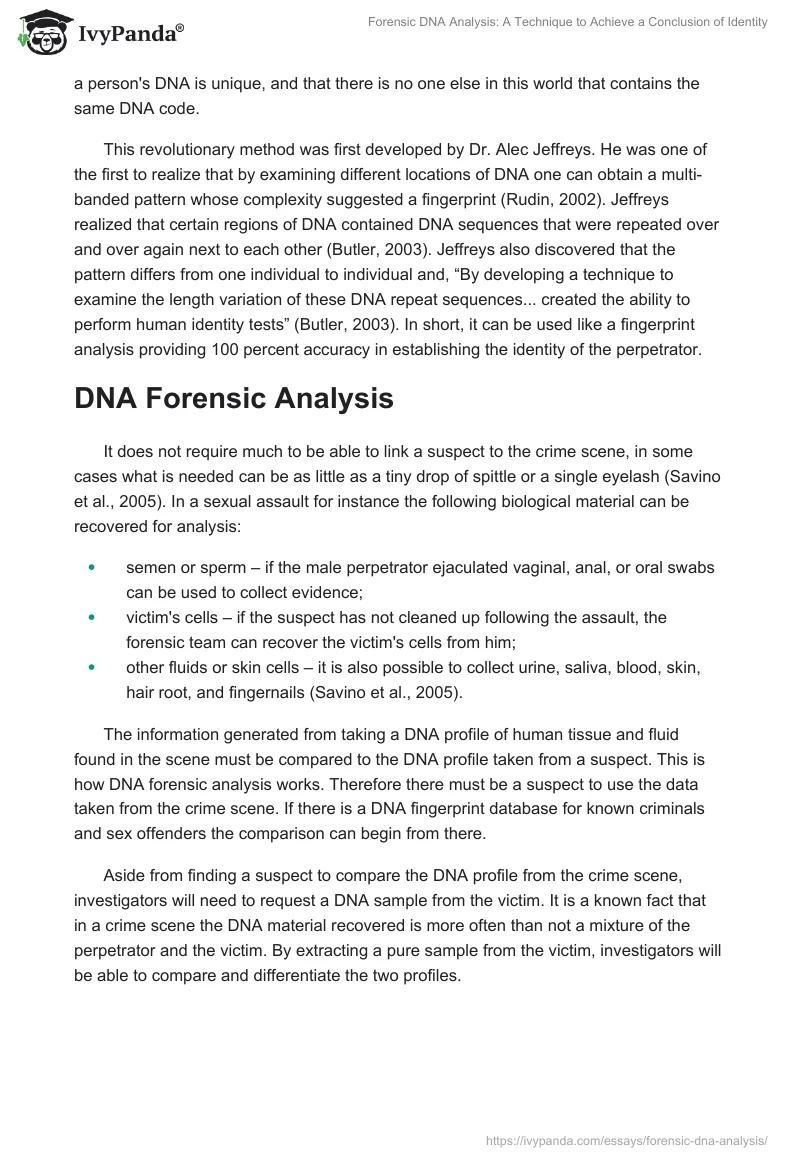In the advent of the 20th century, law enforcers, as well as the justice department, discovered a revolutionary procedure that became known as fingerprinting (Rudin, 2002). When criminals learned to use gloves a new technique was needed to achieve a conclusion of identity. In 1970 Jeffey discovered that human DNA can be examined in such a way to determine its uniqueness. Jeffy was able to establish that DNA can be a fingerprint in that no two human beings can have the same DNA characteristics. Thus, a DNA match corroborates the fact that the suspect was at the scene of the crime and this evidence can help in establishing a case against the suspects. While DNA forensic analysis is an effective and highly reliable method for identifying the perpetrator there are some challenges that the forensic expert needs to overcome in order to efficiently use DNA in solving crimes.
Forensic Science and DNA
According to Tilstone et al., “Forensic science can be defined as it pertains to the law” and pointed out that this simple definition encompasses different scientific or technical procedures as well as three basic principles as enumerated below:
- inceptive evidence – to determine if a crime has been committed;
- testing for exclusion – address the identity or origin of something, e.g. a fingerprint or DNA recovered from the scene to identify the suspect or to exclude someone as a suspect; and
- to gather corroborative evidence – this pertains to other forms of evidence (Tilstone et al., 2006).
As mentioned earlier forensic science no longer relies on fingerprint analysis to identify the perpetrator. In their arsenal, they added DNA analysis. DNA is the human genetic material. This means that the DNA contains information that will dictate the physical characteristics of the person. But in relation to forensic science, the most important feature of DNA is that the code dictates the synthesis of protein, which in turn will dictate the creation of specific proteins, this code is unique in every individual. Thus, a person’s DNA is unique, and that there is no one else in this world that contains the same DNA code.
This revolutionary method was first developed by Dr. Alec Jeffreys. He was one of the first to realize that by examining different locations of DNA one can obtain a multi-banded pattern whose complexity suggested a fingerprint (Rudin, 2002). Jeffreys realized that certain regions of DNA contained DNA sequences that were repeated over and over again next to each other (Butler, 2003). Jeffreys also discovered that the pattern differs from one individual to individual and, “By developing a technique to examine the length variation of these DNA repeat sequences… created the ability to perform human identity tests” (Butler, 2003). In short, it can be used like a fingerprint analysis providing 100 percent accuracy in establishing the identity of the perpetrator.
DNA Forensic Analysis
It does not require much to be able to link a suspect to the crime scene, in some cases what is needed can be as little as a tiny drop of spittle or a single eyelash (Savino et al., 2005). In a sexual assault for instance the following biological material can be recovered for analysis:
- semen or sperm – if the male perpetrator ejaculated vaginal, anal, or oral swabs can be used to collect evidence;
- victim’s cells – if the suspect has not cleaned up following the assault, the forensic team can recover the victim’s cells from him;
- other fluids or skin cells – it is also possible to collect urine, saliva, blood, skin, hair root, and fingernails (Savino et al., 2005).
The information generated from taking a DNA profile of human tissue and fluid found in the scene must be compared to the DNA profile taken from a suspect. This is how DNA forensic analysis works. Therefore there must be a suspect to use the data taken from the crime scene. If there is a DNA fingerprint database for known criminals and sex offenders the comparison can begin from there.
Aside from finding a suspect to compare the DNA profile from the crime scene, investigators will need to request a DNA sample from the victim. It is a known fact that in a crime scene the DNA material recovered is more often than not a mixture of the perpetrator and the victim. By extracting a pure sample from the victim, investigators will be able to compare and differentiate the two profiles.
Challenges
One major problem with DNA fingerprinting is that the sample material such as blood, semen, and other human tissue samples taken from the crime scene is subject to degradation inept handling. Heat can easily destroy evidence and therefore it is important to carefully label and store samples before laboratory technicians will be able to examine each one.
The second major problem is contamination. As long as humans are the first responders to a crime scene and not machines, the human element of the investigation process must be considered. An investigator can easily contaminate the evidence if he or she is not wearing masks or gloves (Savino et al., 2005). When biological materials are collected then DNA profiling can commence. The DNA recovered from the scene can be processed for short tandem repeat markers (STR) using the polymerase chain reaction (PCR) AmpFISTR Profiler Plus and Cofiler typing systems.
Conclusion
It was made clear that investigators are no longer limited to fingerprint analysis in establishing the identity of the perpetrator. But in order to achieve accurate DNA profiling, there is a need to protect the evidence from degradation and contamination. It is also important to get a pure sample from the victim to separate the two profiles coming from victim and perpetrator. So far DNA profiling is one of the best ways to link a criminal to the crime scene. The only challenge is that it is time-consuming and a labor-intensive procedure requiring the assistance of highly skilled personnel. Aside from that DNA profiling requires equipment and other materials that may not be available everywhere. Thus, while DNA profiling is an important tool in solving crime, there may be communities that could not enjoy the benefits of forensic science.
References
- Butler, J. M (2003). Forensic DNA Typing. CA: Academic Press
- Rudin, N. (2002). An Introduction to Forensic DNA Analysis. Boca Raton, Florida: CRC Press.
- Savino, J. O. et al. (2005). Rape Investigation Handbook. CA: Elsevier Academic Press.
- Trent, R. J. (2005). Molecular Medicine. CA: Elsevier Press.
- Tilstone, W. et al. (2006). Forensic Science. CA: ABC-CLIO, Inc.



